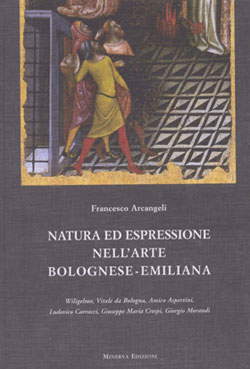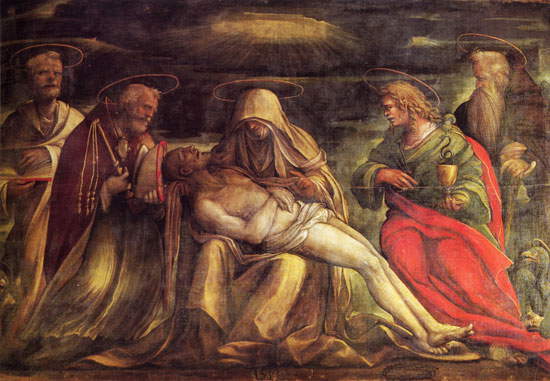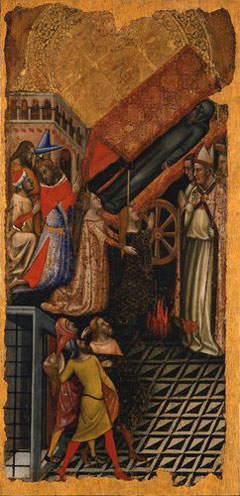After the major exhibition on Guido Reni in 1954, the subsequent Biennali d’Arte Antica also continued to deal with classicist painters: for example, in 1956 it was the turn of the Carracci, in 1962 there was the exhibition L’Ideale Classico nel Seicento, and in 1968 the exhibition was devoted to Guercino. With the 1970 Biennial of Ancient Art, interests changed. That was the year when the project that gave body and substance to years of research by one of the greatest art historians of the 20th century, Francesco Arcangeli, took shape: the exhibition Nature and Expression in Bolognese-Emilian Art. The exhibition opened on September 12, 1970, lasted until November 22, and was held in the halls of the Palazzo dell’Archiginnasio in Bologna.
 |
| The catalog of the exhibition Nature and Expression in Bolognese-Emilian Art edited by Francesco Arcangeli |
This relationship with nature was manifested through a highly charged, highly expressive art with a distinctly popular flavor: Arcangeli traced the origins of this way of making art back to the reliefs of Wiligelmo. We are in the Romanesque period, and with Wiligelmo the hieraticism of Byzantine art gives way to a more notably human narrative, in which the drama of the characters the artist represents in his sculpture is tangible. The reliefs of Genesis on the façade of Modena Cathedral, with one of the most powerful expulsions from Earthly Paradise in the history of art, are worth mentioning, merely as an example: the despair of the progenitors is tangible. Let us not forget, then, that art in the Po Valley, and in particular in Emilia, gave great importance to work in the Romanesque period: cycles known as “of the months” abound in this era, in which each month of the year is associated with the figure of a character devoted to a typical trade of the month.
This link between art and nature, this worldview rooted in the peasant traditions of the Po Valley civilization, will represent a kind of common thread that will run throughout the history of Bolognese art up to the present day. Think, for example, of the drama of an artist like Vitale da Bologna, or again of the"anti-Renaissance," to use Arcangeli’s words, of Amico Aspertini, one of the most bizarre and irreverent geniuses of the sixteenth century, who opposed his art to the more lyrical and delicate art of Francesco Francia, which was instead imbued with the sweetness derived from his study of Perugino’s art. From the sixteenth century we move on to the seventeenth with the devotional and almost popular pietism of Ludovico Carracci, whom Arcangeli saw as a figure in stark contrast to his cousin Annibale, an exponent instead of a graceful classicism. The anticlassical, everyday scenes of Giuseppe Maria Crespi continued this line of Bolognese art throughout the eighteenth century, until we reach the twentieth century with the intimate still lif es of Giorgio Morandi, the artist perhaps more than any other capable of representing the simplicity and genuineness of the character of the Bolognese.
 |
| Amico Aspertini, Pietà (1519; Bologna, San Petronio). |
This, in essence, is the itinerary of Francesco Arcangeli’s exhibition Nature and Expression. A journey eight centuries long, during which, however, some common features of Bolognese art, for Arcangeli, remain unchanged. In the exhibition catalog he identified, in a systematic way, eight of them. They are “constants,” as the scholar called them. The first: the space of the painting, “dense and full-bodied,” full of bodies, “essentially aprospective.” A space therefore intuitive, charged, regulated not by mathematical laws but by the very bodies that occupy it. An example is Amico Aspertini’s Pietà, a painting not only full of very strong pathos, but also connoted by that “dense” and “aprospective” space of which Arcangeli spoke, in that it is voidless, entirely occupied by the characters and devoid of spatial references. A painting, in some ways, anticipatory of Mannerism. The second: spatial proximity. Arcangeli identifies a constant in Bolognese art in the fact that the elements depicted in the painting are always close to the viewer. This is because proximity, on an emotional level, succeeds in engaging the viewer more, as opposed to distance, which involves detachment. The third, direct consequence of the first two: spatial communication with the viewer, with the scenes tending to always take place in the foreground.
 |
| Vitale da Bologna, Stories of St. Anthony Abbot (c. 1340; Bologna, Pinacoteca Nazionale) |
The aim of Francesco Arcangeli’s exhibition was to bring out this groove in the Bolognese tradition, bringing it closer to the more solemn, more official (and, of course, more studied) groove of the classicist tradition: succeeding in this goal also meant bringing Bologna into possession of one of its truest and deepest souls. There had to be an art that reflected the cordial, sincere, and passionate character of the Bolognese, and this art could only be an art linked to popular traditions, linked to roots: so much so that, for the first time, the origins of Bolognese art were traced back not to the fourteenth century, but even to Wiligelmo, thus to a time when the rhythms of human life were strongly marked by those of nature, long before the rise of the bourgeoisie introduced an economy based on commerce and mercantile trade rather than agriculture, and thus went on to radically alter the lifestyles of communities. With Francesco Arcangeli’s exhibition, noble classicist elegances were, for the first time, contrasted with popular authenticity. The “learned” Bologna of the refined intellectuals versus the “fat” Bologna of the peasants who hung out in the osterie, the generous young housewives, and the commoners who traded under the porticoes: it is therefore to Francesco Arcangeli’s credit that today, in studying Bolognese art, this more popular, but no less interesting, type of art cannot be put on the back burner.
 |
| Giuseppe Maria Crespi, Latona transforms fishermen into frogs (c. 1710; Bologna, Pinacoteca Nazionale) |
Warning: the translation into English of the original Italian article was created using automatic tools. We undertake to review all articles, but we do not guarantee the total absence of inaccuracies in the translation due to the program. You can find the original by clicking on the ITA button. If you find any mistake,please contact us.